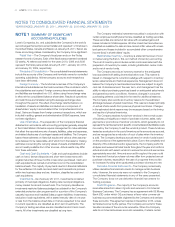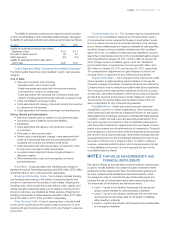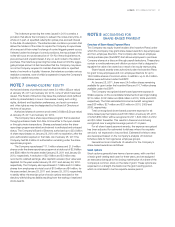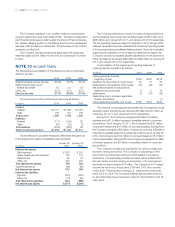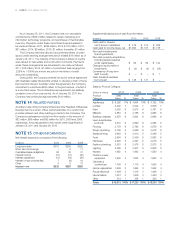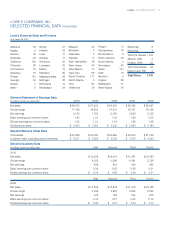Lowe's 2010 Annual Report Download - page 41
Download and view the complete annual report
Please find page 41 of the 2010 Lowe's annual report below. You can navigate through the pages in the report by either clicking on the pages listed below, or by using the keyword search tool below to find specific information within the annual report.
LOWE’S 2010 ANNUAL REPORT 37
Theliabilityforextendedprotectionplanclaimsincurredisincluded
in other current liabilities on the consolidated balance sheets. Changes in
theliabilityforextendedprotectionplanclaimsaresummarizedasfollows:
(In millions) 2010 2009
Liabilityforextendedprotectionplanclaims,
beginningofyear $23 $17
Accrual for claims incurred 80 67
Claim payments (83) (61)
Liabilityforextendedprotectionplanclaims,
endofyear $20 $23
CostofSalesandSelling,GeneralandAdministrativeExpenses –
Thefollowingliststheprimarycostsclassiedineachmajorexpense
category:
Cost of Sales
• Totalcostofproductssold,including:
- Purchase costs, net of vendor funds;
-Freightexpensesassociatedwithmovingmerchandise
inventories from vendors to retail stores;
- Costs associated with operating the Company’s distribution
network, including payroll and benefit costs and occupancy costs;
• Costsofinstallationservicesprovided;
• Costsassociatedwithdeliveryofproductsdirectlyfromvendors
to customers by third parties;
• Costsassociatedwithinventoryshrinkageandobsolescence.
Selling, General and Administrative
• Payrollandbenetcostsforretailandcorporateemployees;
• Occupancycostsofretailandcorporatefacilities;
• Advertising;
• Costsassociatedwithdeliveryofproductsfromstores
to customers;
• Third-party,in-storeservicecosts;
• Tendercosts,includingbankcharges,costsassociatedwith
credit card interchange fees and amounts associated with
accepting the Company’s proprietary credit cards;
• Costsassociatedwithself-insuredplans,andpremiumcosts
for stop-loss coverage and fully insured plans;
• Long-livedassetimpairmentlossesandgains/losseson
disposal of assets;
• Otheradministrativecosts,suchassupplies,andtravel
and entertainment.
Advertising – Costs associated with advertising are charged to
expenseasincurred.Advertisingexpenseswere$790million,$750million
and$789millionin2010,2009and2008,respectively.
Shipping and Handling Costs – The Company includes shipping
and handling costs relating to the delivery of products directly from
vendors to customers by third parties in cost of sales. Shipping and
handling costs, which include third-party delivery costs, salaries, and
vehicleoperationsexpensesrelatingtothedeliveryofproductsfrom
storestocustomers,areclassiedasSG&Aexpense.Shippingand
handlingcostsincludedinSG&Aexpensewere$431million,$371million
and$378millionin2010,2009and2008,respectively.
Store Opening Costs – Costs of opening new or relocated retail
stores, which include payroll and supply costs incurred prior to store
openingandgrandopeningadvertisingcosts,arechargedtoexpense
as incurred.
Comprehensive Income – The Company reports comprehensive
income on its consolidated statements of shareholders’ equity.
Comprehensive income represents changes in shareholders’ equity
from non-owner sources and is comprised primarily of net earnings
plus or minus unrealized gains or losses on available-for-sale securities,
as well as foreign currency translation adjustments. Net unrealized
gains,netoftax,onavailable-for-salesecuritiesclassiedinaccumu-
lated other comprehensive income on the consolidated balance sheets
wereinsignicantatJanuary28,2011and$2millionatJanuary29,
2010.Foreigncurrencytranslationgains,netoftax,classiedin
accumulatedothercomprehensiveincomewere$53millionand
$25millionatJanuary28,2011andJanuary29,2010,respectively.
The reclassification adjustments for gains/losses included in net
earnings were not significant for any of the periods presented.
Segment Information – The Company’s home improvement retail
stores represent a single operating segment based on the way the
Company manages its business. Operating decisions are made at the
Company level in order to maintain a consistent retail store presentation.
The Company’s home improvement retail stores sell similar products
and services, use similar processes to sell those products and services,
and sell their products and services to similar classes of customers.
The amounts of long-lived assets and net sales outside of the U.S.
were not significant for any of the periods presented.
Reclassifications – Certain prior period amounts have been
reclassified to conform to current classifications. Store opening costs,
which were previously reported as a separate line item on the consoli-
datedstatementsofearnings,havebeencombinedwithSG&Aexpense.
In addition, activity that was previously separately presented for short-
term and long-term investments on the consolidated statements of
cashowswascombinedintosinglelineitemsforpurchasesofinvest-
ments and proceeds from the sale/maturity of investments. Proceeds
from the issuance of common stock under the employee stock purchase
planandfromstockoptionsexercised,whichwerepreviouslyreported
asseparatelineitemsontheconsolidatedstatementsofcashows,
were also combined into a single line item. In addition, deferred
revenue–extendedprotectionplans,whichwaspreviouslyincluded
in other liabilities (noncurrent), is now a separate line item on the
consolidated balance sheets.
NOTE 2 FAIR VALUE MEASUREMENTS AND
FINANCIAL INSTRUMENTS
Fair value is defined as the price that would be received to sell an asset
or paid to transfer a liability in an orderly transaction between market
participants at the measurement date. The authoritative guidance for
fair value measurements establishes a three-level hierarchy, which
encouragesanentitytomaximizetheuseofobservableinputsand
minimize the use of unobservable inputs when measuring fair value.
The three levels of the hierarchy are defined as follows:
• Level1–inputstothevaluationtechniquesthatarequoted
prices in active markets for identical assets or liabilities
• Level2–inputstothevaluationtechniquesthatareotherthan
quoted prices but are observable for the assets or liabilities,
either directly or indirectly
• Level3–inputstothevaluationtechniquesthatareunobservable
for the assets or liabilities









